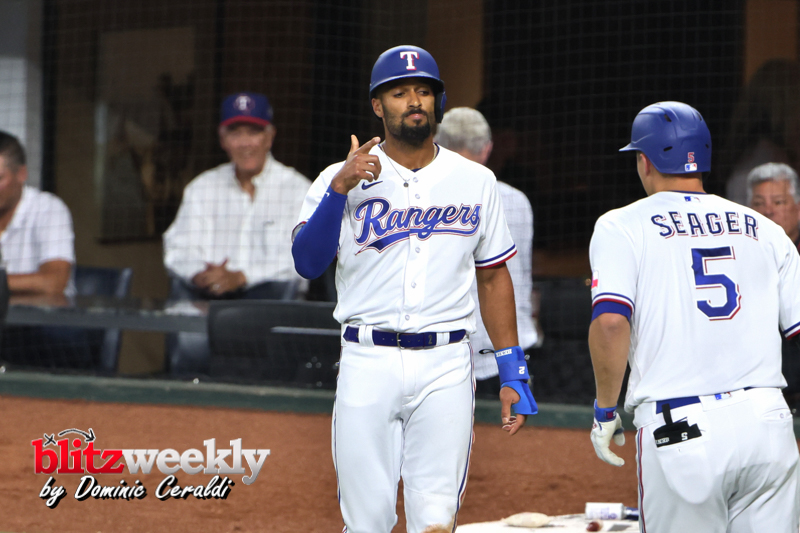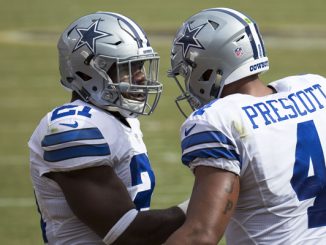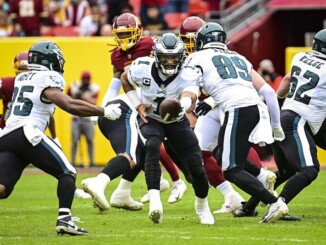
They did it. They finally did it. After decades of ineptitude the Texas Rangers finally won the World Series. The Rangers are no longer defined by Game Six of the 2011 World Series. This World Series win was franchise defining. The Rangers can no longer be dismissed as perennial second division dopes. The ALCS that preceded the World Series defined the playoff run. It was a seven game classic against the Rangers biggest rival. Once the Rangers emerged from the caustic fray they faced an unlikely opponent: The Arizona Diamondbacks.
Game 1: It is uncommon for game one of a World Series to be the game that defines the series. Frequently the trajectory of the best of seven can be altered and redefined after the opening salvo. The Rangers first ever World Series game ended up defining the entire series. That was back in 2010 when Cliff Lee faced off against Tim “The Freak” Lincecum in San Francisco. Michael Young made a crucial error in that game that led to a big inning for the Giants. He also made two errors in the infamous 2011 game six disaster. Michael Young was a butcher in the field and his defensive ineptitude is a big reason why those teams of old never won a World Series. The Giants captured momentum in that series early and the Rangers never recovered. This put them in a position to have to play two “must” win games in Three and Four. They won Game Three, their first ever home World Series win. Unfortunately they lost Game Four, the first World Series game I ever attended. Going down 3-1 and having to face The Freak and Matt Cain again was a death sentence.
Zac Gallen faced off against Nathan Eovaldi to begin the Fall Classic. Gallen is a bespectacled righty that throws hard and has a big curveball. Nathan Eovaldi is the playoff tested flamethrowing righty with a nasty splitter. He carried the Rangers through May after Jacob deGrom blew his arm out. It is so interesting to consider all the little pieces and contributions that go into a World Series season. Usually when one reflects on a Rangers season the positive elements are seen as something nice that is to be built upon. It is odd to view the 2023 season through the lens of how they ended up winning it all. Frankly, the fact they won the World Series at all is still staggering. That is why this article took so long to write. This is more than just a report on the World Series, but a reflection upon the ending of decades of misery. The Rangers were rapidly approaching Chicago Cubs territory without a World Series title. Their most famous moments were getting embarrassed by David Freese and Joey Bats. The Rangers were not only a joke franchise, but a franchise who would implode in spectacular fashion. The specter of 2011 Game Six still looms large over this franchise. That atrocity was just as brutal as 1986 World Series Game Six (The Bill Buckner Game) and 2003 NLCS Game Six (Mark Prior’s Immortal Game.) The repugnant, spectacular nature of the disaster does not get the credit it deserves because it happened to the Rangers, and not the lovable loser Cubs or the Cursed Boston Red Sox. Understanding the level of suffering and sorrow brought on by the 2011 disaster is crucial when contextualizing game one of this World Series. The Rangers were perceived as a snakebit, loser franchise that would screw it up no matter how close they got to the finish line.
Eovaldi and Gallen were both decent but failed to record a quality start. The D-Backs were up 5-3 in the 5th inning when Rangers skipper Bruce Bochy showed off his Hall of Fame pedigree. The Rangers biggest weakness by far going into the playoffs was their bullpen. Bochy maximized the arms he had on the roster to a nearly unfathomable level. Bochy brought in lefty rookie Cody Bradford, flamethrowing starter Jon Gray, and beleaguered ex-closer Will Smith successively to get 3.1 IP of scoreless work out of his patchwork bullpen. The Rangers title run was defined by Bochy using his pitchers in a unique and creative way to maximize his talent on his roster. The players, especially the starters like Jon Gray, did a great job being adaptable.
The atmosphere at the ballpark crackled with electric anticipation as the Rangers trailed 5-3 going into the bottom of the 9th. The inning began as many rallies do: with a leadoff walk. After the Leody Taveras leadoff walk, Marcus Semien struck out. Corey Seager came to the plate looking to build on the best season of his career. He placed 2nd in the MVP race after blistering the league all season, save the month he missed early after pulling his hamstring against the Royals. Seager looked like Prime Jason Giambi as he launched a Paul Sewald pitch into the stratosphere. Seager let out a thunderous yell of triumph as he saw the ball rise and rise. The game-tying homer ranks near the top of all-time moments in Rangers history. The game went into extras and Jose Leclerc pitched two perfect frames. In the bottom of the 11th Adolis “El Bombi” Garcia blasted a walkoff solo shot to right field. This classic game will go down as one of the most important games in Rangers history. It is also one of the best Game Ones in World Series history. Win 6-5.
Game 2: Merrill Kelly and Jordan Montgomery dueled in this game the D-Backs had to have. They were both sharp. The D-Backs held a 2-1 lead going into the seventh. The Rangers lone run came off of a Mitch Garver solo blast. Garver is an offensive-first catcher with lots of pop. His career has been marred by injuries, but when healthy he is a great DH. The Rangers rode their primary catcher, Jonah Heim, insanely hard down the stretch and through the playoffs. His durability and toughness are beyond reproach. Monty ran out of gas in the 7th and the D-Backs scored a couple of runs after Andrew Heaney came in. Merrill Kelly emptied the tank in the bottom half of the 7th, striking out his 9th batter to cap an S class performance. Chris Stratton and Martin Perez reminded everyone why the Rangers bullpen was considered weak going into the playoffs. Five runs were scored by the D-Backs in the final two frames to mar the final line. This game was reminiscent of Game Two of the 2010 World Series. An affair that was a close pitchers duel for the majority of the game until the leading team poured it on late. Loss 9-1.
Game 3: Mad Max Scherzer started this crucial game for the Rangers. It was the first World Series game in Arizona since they beat the Yanks in Game Seven of the 2001 World Series. Mad Max was one of the best pitchers in baseball a few years ago. He is 38 years old and a diminished version of himself. Mad Max possesses a true warrior’s spirit. A sort of ultra-confidence and machismo that all the best pitchers have. Like most great power pitchers, Max seems to have a screw loose while on the mound. Talking to himself angrily, frothing at the mouth, mismatched eyes ablaze, Mad Max retired the D-Backs easily in the 1st. He ran into trouble in the 2nd when Christian Walker smoked a leadoff double to the gap. Tommy Pham, who was great all World Series long, smacked a hit to right field. Walker blew through the stop sign and El Bombi gunned him down at the plate. The inning ended with a line drive hitting Mad Max in his pitching elbow, bouncing to Josh Jung, and Jung throwing to 1st. That was Mad Max’s penultimate inning. He would exit after the third inning due to season ending back issues. He has since had surgery and will miss some time at the beginning of next year.
Nate Lowe led off the top of the 3rd with a double. Marcus Semien singled him home to give the Rangers the 1-0 lead. Corey Seager followed with a two out homer. The Rangers led 3-0 but needed to get 7 innings out of their beleaguered bullpen. Jon Gray was picked for this difficult task. He was exceptional. He is one of the most underrated pitchers in all of baseball. He has struggled with injury throughout his career, but when he is healthy he is phenomenal. He throws very hard with great control and has a nasty slider. Gray turned in 3 innings of God tier relief from a bullpen that really had to way to fill those middle innings. Josh Sborz came in for the 7th inning and was exceptional. Sborz was perhaps the most valuable player in the entire playoff run. Seager was on fire, El Bombi was clutch, Monty stood tall in the big games, but it was Josh Sborz who was asked to get crucial outs repeatedly in the playoffs. He stood tall over and over in the big playoff moments like John Rocker. Throughout the regular season Sborz displayed ridiculous inconsistency. He was either elite or awful. In the playoffs he never entered a game without his control. This enabled him to showcase his grotesquely filthy stuff. He throws very hard, has a vicious curveball and a biting slider. Sborz’s excellence was exceptionally important considering how weak the bullpen was.
The Rangers were up 3-0 going into the 8th when known playoff choker Aroldis “The Cuban Missile” Chapman entered the game as the setup man. Adolis Garcia pulled his oblique in the top half of the inning and had to be replaced. Oblique injuries are never minor and almost always require at least three weeks to heal. It was clear the emotional leader of the team was not going to play again in the series. The Rangers had to have this game. They lost one of their aces and a dynamic hard carry in Garcia in the same game. Chapman immediately gave up a single to the 8th place hitter. He then threw a hilariously bad hanging slider to Corbin Carroll, who was stunned into inaction and watched strike three down the middle. Corey Seager then made his second most important play of the World Series: a brilliant diving stab and shovel pass to a waiting Marcus Semien to begin an inning ending double play. Chapman was clearly in the middle of a brewing meltdown and got absolutely bailed out.
Even though this series ended in five games it is important to remember how changing even one of these factors could have a cascading effect on the rest of the game and series. The importance of the Seager double play, the Rocker-like consistency of Josh Sborz, the prowess of Evan Carter… without these things the Rangers could have faltered as the injuries mounted. Jose Leclerc came in and shut the door in the 9th to secure the 3-1 lead. This game was incredibly entertaining and important. If the Rangers lost, it could have easily defined the series because of the injuries, and the fact the D-Backs would then be ahead. That goes back to the aforementioned element of momentum in a series, and how game one is rarely the most important game. Had the Rangers choked game three and lost the series, game three would have been the defining game of the series. But since they held strong, game one remained the defining game of the series. Game three was important because the Rangers showed their resolve. Win 3-1.
Game 4: Andrew Heaney started for the Rangers. The Rangers opened the scoring in the 2nd on a wild pitch. Travis Jankowski had a single after the wild pitch to put two men on. Marcus Semien came up after and laced a triple to the left field corner. Corey Seager came up after and blasted a homer to give the Rangers a nice 5-0 lead. The best offense in the AL continued the assault in the 3rd when Jankowski stroked a double with bases juiced. Jankowski’s speed and defense were an asset all season. He also hit over .300 for most of the year. The Rangers bullpen and outfield were their weaknesses going into the season. Jankowski stepping up along with the solid play of Robbie Grossman helped negate this weakness. After Jankowski’s double, Marcus Semien came up and delivered a brutal finishing move that even Vegeta would appreciate. Semien blasted a homer to make the game a staggering 10-0. Semien set the record for most plate appearances in a season this year. The wear was starting to show and Marcus was a bit cold going into this game. He brutalized the D-Backs in this affair. This was perhaps the most tenuous ten run lead in baseball history. To give you an idea of how bad the Rangers bullpen is: they entered the 8th inning up 11-1 and ended up having to use their closer. Win 11-7.
Game 5: The Rangers entered Game Five of the World Series up 3-1. They also used a remarkable amount of bullpen arms in the previous game and had multiple injured stars. Gallen vs Eovaldi again. Eovaldi walked the leadoff man Carroll, who stole 2nd, but failed to score. Gallen had his A+ stuff and was incredible. He and Eovaldi traded 0’s through the early innings. The first two D-Backs reached base in the 3rd, were bunted over, but Eovaldi struck out the next batter and got the 3rd out on a groundout. Josh Jung was robbed of a double in the 5th. Eovaldi ran into trouble in the bottom of the 5th when the D-Backs loaded the bases, but he escaped again after a mound visit. This inning was crucial because Gallen had a no hitter going and Eovaldi showed his steely resolve.
Eovaldi finally had an easy inning in the 6th when he struckout two. As Eovaldi struggled, clawed, and scrapped to make it through six innings, Zac Gallen had a no hitter through six innings. The top of the seventh began with Corey Seager hilariously breaking up the no hitter with a weakly hit grounder through the yawning shifted infield by third base. Evan Carter, called “The Little Savior” by his older teammates, stroked a double to right. He was incredible through the entire playoffs. Mitch “Garvesauce” Garver slammed a single to give the Rangers a 1-0 lead. Josh Sborz was electric in the 8th to hold the small lead. Remember the context of the series up until this point: the Rangers are dopey chokers expected to figure out a way to blow it and their team is falling apart with injuries.
The top of the 9th begins with Josh Jung hammering a single right back up the middle off of Paul Sewald. Nate Lowe followed with a single of his own. Jonah Heim then stroked a single into center field, which Alek Thomas hilariously overran as the ball rattled to the wall. It was at this moment I felt a pang of hope in spite of myself for the first time since 2011 Game Six. Marcus Semien delivered a killshot homer to make the game 5-0. Josh Sborz stayed in to close the game, as the Rangers had to blow their closer in the previous game which they led 10-0 at one point. Sborz struck out the final batter and the Rangers won their first World Series in team history. Win 5-0.
The Rangers finally winning the World Series completely changes the way the franchise is viewed. Credit should be given to the brilliant GM Chris Young, who assembled the team. Bruce Bochy deserves a plethora of credit too. His bullpen management was exceptional. The way he maximized his resources was spectacular. He got the most out of his players. He went into the playoffs with essentially no bullpen. His stable, calm style was the opposite of firebrands like Billy Martin or Big Dallas Green. Bochy’s level demeanor helped this team go a staggering 11-0 on the road in the playoffs. The Rangers could not have won the pennant without Bochy. He is a future Hall of Famer.
The Rangers are no longer defined by 2011. Their future is very bright.




